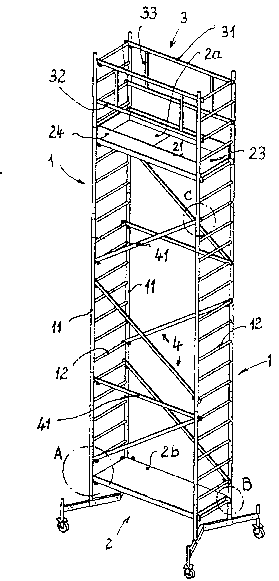Some of the information on this Web page has been provided by external sources. The Government of Canada is not responsible for the accuracy, reliability or currency of the information supplied by external sources. Users wishing to rely upon this information should consult directly with the source of the information. Content provided by external sources is not subject to official languages, privacy and accessibility requirements.
Any discrepancies in the text and image of the Claims and Abstract are due to differing posting times. Text of the Claims and Abstract are posted:
| (12) Patent Application: | (11) CA 2192482 |
|---|---|
| (54) English Title: | CLAMP CONNECTOR FOR THE ASSEMBLY OF PREFABRICATED SHAPED-SECTION BARS TO FORM SCAFFOLDING |
| (54) French Title: | DISPOSITIF DE RACCORDEMENT A BLOCAGE POUR ASSEMBLER DES BARRES PROFILEES PREFABRIQUEES ET FORMER UN ECHAFAUDAGE |
| Status: | Deemed Abandoned and Beyond the Period of Reinstatement - Pending Response to Notice of Disregarded Communication |
| (51) International Patent Classification (IPC): |
|
|---|---|
| (72) Inventors : |
|
| (73) Owners : |
|
| (71) Applicants : |
|
| (74) Agent: | SMART & BIGGAR LP |
| (74) Associate agent: | |
| (45) Issued: | |
| (86) PCT Filing Date: | 1995-05-12 |
| (87) Open to Public Inspection: | 1995-12-21 |
| Availability of licence: | N/A |
| Dedicated to the Public: | N/A |
| (25) Language of filing: | English |
| Patent Cooperation Treaty (PCT): | Yes |
|---|---|
| (86) PCT Filing Number: | PCT/EP1995/001805 |
| (87) International Publication Number: | WO 1995034727 |
| (85) National Entry: | 1996-12-09 |
| (30) Application Priority Data: | ||||||
|---|---|---|---|---|---|---|
|
A clamp connector for scaffolding must not only make
it possible to join two scaffolding components rapidly
and securely but also be inexpensive to manufacture, have
long life and be suitable for use with a wide variety
of scaffolding designs. To this end, the invention calls
for there to be an aperture (PA) in each of the shaped-
section bars of the scaffolding units to be fixed
together, the aperture being designed to hold a cross-
bar (121 and to be locked by a moving clamp (6).
L'invention vise à mettre au point un dispositif de raccordement à blocage pour échaffaudage qui permette d'une part d'assembler rapidement et de manière fiable deux éléments d'échafaudage, tout en étant par ailleurs économique à réaliser et durable, et adapté à des éléments d'échaffaudage de structures très diverses. A cet effet, il est prévu que les barres profilées des éléments d'échaffaudage à fixer comportent au moins une cavité (PA) retenant une traverse (12), et pouvant être fermée à l'aide d'une pièce de blocage (6) mobile.
Note: Claims are shown in the official language in which they were submitted.
Note: Descriptions are shown in the official language in which they were submitted.

2024-08-01:As part of the Next Generation Patents (NGP) transition, the Canadian Patents Database (CPD) now contains a more detailed Event History, which replicates the Event Log of our new back-office solution.
Please note that "Inactive:" events refers to events no longer in use in our new back-office solution.
For a clearer understanding of the status of the application/patent presented on this page, the site Disclaimer , as well as the definitions for Patent , Event History , Maintenance Fee and Payment History should be consulted.
| Description | Date |
|---|---|
| Inactive: IPC from MCD | 2006-03-12 |
| Inactive: IPC from MCD | 2006-03-12 |
| Time Limit for Reversal Expired | 2003-05-12 |
| Application Not Reinstated by Deadline | 2003-05-12 |
| Inactive: Status info is complete as of Log entry date | 2002-06-26 |
| Inactive: Abandon-RFE+Late fee unpaid-Correspondence sent | 2002-05-13 |
| Deemed Abandoned - Failure to Respond to Maintenance Fee Notice | 2002-05-13 |
| Letter Sent | 1997-10-14 |
| Reinstatement Requirements Deemed Compliant for All Abandonment Reasons | 1997-09-26 |
| Deemed Abandoned - Failure to Respond to Maintenance Fee Notice | 1997-05-12 |
| Application Published (Open to Public Inspection) | 1995-12-21 |
| Abandonment Date | Reason | Reinstatement Date |
|---|---|---|
| 2002-05-13 | ||
| 1997-05-12 |
The last payment was received on 2001-05-01
Note : If the full payment has not been received on or before the date indicated, a further fee may be required which may be one of the following
Please refer to the CIPO Patent Fees web page to see all current fee amounts.
| Fee Type | Anniversary Year | Due Date | Paid Date |
|---|---|---|---|
| Registration of a document | 1997-01-16 | ||
| Reinstatement | 1997-09-26 | ||
| MF (application, 2nd anniv.) - standard | 02 | 1997-05-12 | 1997-09-26 |
| MF (application, 3rd anniv.) - standard | 03 | 1998-05-12 | 1998-04-23 |
| MF (application, 4th anniv.) - standard | 04 | 1999-05-12 | 1999-04-30 |
| MF (application, 5th anniv.) - standard | 05 | 2000-05-12 | 2000-04-27 |
| MF (application, 6th anniv.) - standard | 06 | 2001-05-14 | 2001-05-01 |
Note: Records showing the ownership history in alphabetical order.
| Current Owners on Record |
|---|
| KRAUSE-WERK GMBH & CO. KG |
| Past Owners on Record |
|---|
| GUNTHER KRAUSE |